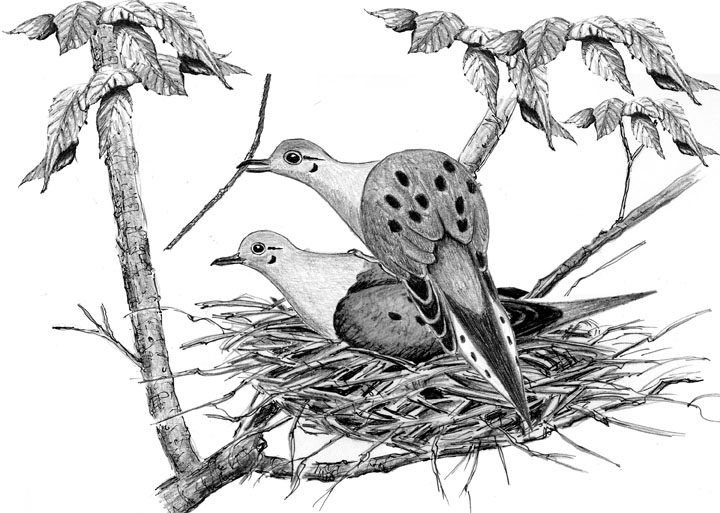
Dear Bird Folks,
I was eating lunch in my car today when a Mourning Dove landed on my roof. So, I rolled down the car window and tossed out a few seeds, which the dove quickly started eating. Next, I tipped my side mirror so I could watch it eat while I continued with my lunch. I thought about giving my new pal a name, but I wasn’t sure if it was a male or a female. Without getting too personal, is there a way to tell a male from a female Mourning Dove?
– Amy, Brewster, MA
Good for you, Amy,
I think most folks would freak out if a bird landed on their car, or at least they wouldn’t offer it seed. It was nice of you to be so generous. As for not “getting too personal” when discussing the sex of a dove, I‘ll try to be delicate. But I think if you are old enough to have your own car, you should be okay with what I’m about to tell you…I hope.
With some birds, like Red-winged Blackbirds for example, the male and female look so different from each other that you wouldn’t even think they were related. The male red-wing has his signature red wing patch, while the rest of his body is jet black. The female red-wing has no black at all, but instead is streaky brown, looking like a sparrow that has taken too many growth hormones. Other species, such as Blue Jays, are nearly indistinguishable from one another. I don’t even know how they can figure out who is who. Last are the birds in which the sexes only have subtle differences (like human couples who been married for a long time). Mourning Doves are in this last group. Even though it is possible to distinguish a male dove from a female, it’s not easy. In order to get it right you’ll need good lighting and a decent pair of binoculars, or at least a really good side mirror on your car.
When it comes to overall appearance, Mourning Doves are never going to be confused with peacocks or one of the stars of Project Runway. Even by dove standards, these birds are dull. With the exception of a few black spots here and there, they are basically covered in a wash of gray-brown. Yet, if you look carefully, you may see a dove with a slight hint of pink on the breast and a touch of light blue on the neck and head. These faint colors belong to the male Mourning Dove. The female has no such extra coloring, which is much to her chagrin. Actually, she probably doesn’t care about her coloring, but I just remembered how to spell “chagrin” and wanted to use it before I forgot again.
What Mourning Doves lack in color they make up for with their beautiful singing skills. Mourning Doves have long been considered to be the premier vocalists of the bird world. Nah, I’m just kidding. The only thing more lackluster than a dove’s plumage is its song. Its mournful “coo” is so monotonous I think the bird itself gets bored with it. But Mourning Doves are an extremely successful species, proving that birds don’t need to look good or sound fancy in order to flourish. By some estimates, there are 450 million Mourning Doves in North America. This means there are more doves here than there are humans. These hardy birds have somehow been able to thrive without such human comforts as heat, running water or Netflix. How is that even possible? I don’t know.
You might think for doves to amass such an enormous population they would need to crank out huge families, just like ducks or turkeys do. Surprisingly, this is not the case. A Mourning Dove’s nest typically consists of just two eggs. That’s all. And unlike ducks and turkeys, where the female receives very little help from her mate, male doves are dedicated fathers. He not only provides food for his babies, but he also shares the incubating duties and even helps with nest construction…in kind of a whacky way. Check this out. With his mate already sitting on the half-built nest, he will fly in with a fresh twig just for her. But instead of landing on an adjacent branch and passing her the twig, he often lands directly on her back. (Don’t worry, Amy, this won’t be too personal.) The female then has to twist her head around in order to receive the twig. It’s a rather bizarre sight. While I can’t say for sure, I’ll the bet the expression, “Get off my back” originated from a moody female Mourning Dove (much to the chagrin of the male).
Speaking of odd Mourning Dove behavior: For the past few weeks a young dove has been hanging around our shop. When we arrive in the morning the dove is waiting for us, often landing on my head (really) while I’m unlocking the door. I have to quickly toss out some birdseed in order to get the bird to fly off. Why is this bird so tame? It’s probably a Wildcare bird. Wildcare is Eastham’s wonderful wildlife rehabilitation facility that cares for orphaned baby birds. I have a feeling this baby still has an attachment to humans and misses its caregivers at Wildcare. Either that or the bird is simply mistaking my hair for a nest, which isn’t the first time that’s happened.
Check your dove for signs of blue or pink, Amy. If you see any of those colors, it’s probably a male. Also, if you get out of your car and the bird lands on your back while carrying a twig, it’s a male for sure. But if it lands on your head, it’s probably looking for me.